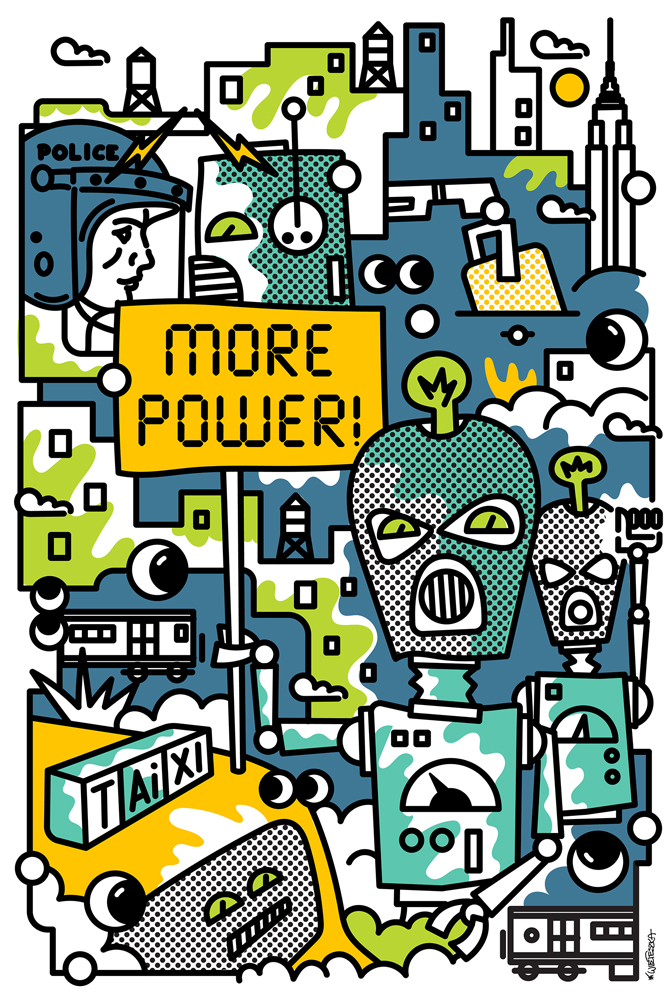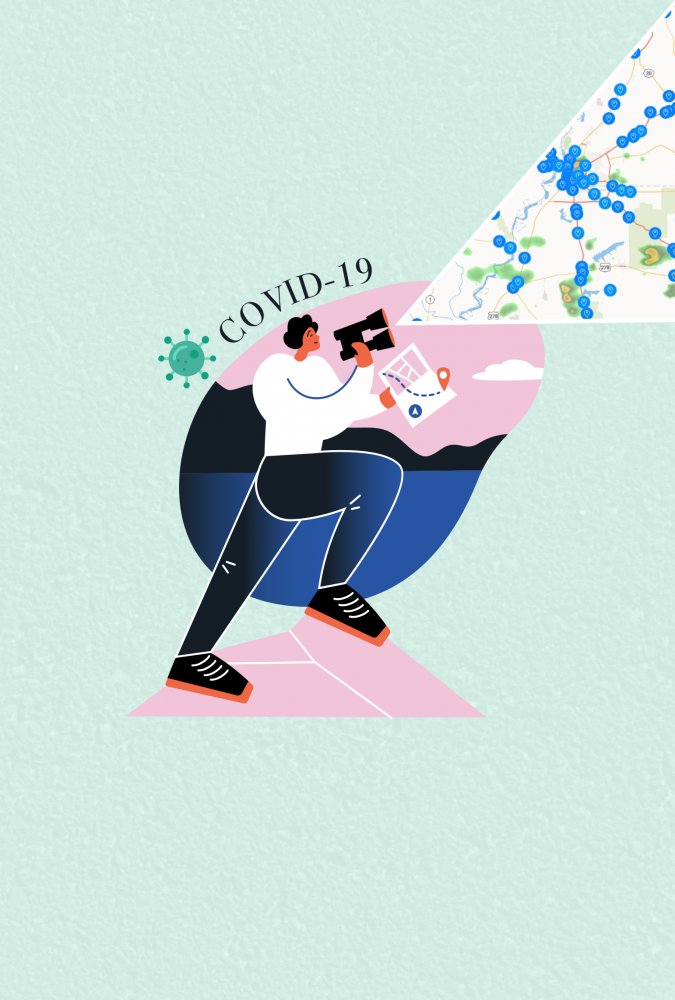
Architect Vishaan Chakrabarti gives us an insightful read on technology and the relationship it has with our cities.
Let’s start off with a little bit about you. Can you give us a brief personal background and a high-level overview of the work you do at PAU?
Sure. I’m an architect and planner; I’ve been working in the studio for nearly 25 years now. Most of that time was spent in New York, although I went to architecture school out in Berkeley. I founded the Practice for Architecture and Urbanism (PAU) in 2015, and over three years our team has grown to 27 people. We do a wide range of work in architecture and large-scale city planning. Most of our work is in New York, some of it is in Philadelphia, and I’ve got a couple of things in Mongolia—that one’s a long story. We’re having a lot of fun. We’re very focused on our mission of advancing future cities.
Do you work a lot with cities directly?
Right now, we have a major contract with the City of New York, working on the master plan for Sunnyside Yard. It’s a 180-acre railyard in western Queens that is mostly publicly owned. That’s about an 18 month study—we’re running a team of engineers, and they’re turning the financial consultants, and so forth.
That’s great. So, today we’re talking about technology and the relationship it has with our cities. Can you give us an example or two of modern-day innovations that have helped or are currently helping to progress the state of our cities?
It’s interesting, because I think about these things in a kind of circular and postern linear way. What I mean by that is I think we’re returning to some of our most fundamental technology as human beings with walking and biking. I know that doesn’t sound overly technological, but think about it: we converted our cities to car-dependency in the 20th century, and we became very, very focused on that technology. That ended up having a lot of negative effects on our society in terms of fossil fuel use. Not only that, but we’ve also come to see how it can be a very inefficient and inequitable way for space to be used in a city. It tends to be segregating, like people living in bubbles and leading to spatial segregation of suburbs.
In recent years, we have rediscovered the idea of walkable and bikeable cities. The shared economy has allowed for young people to say, “Well I don’t need to own a car, I can use Uber or Lyft.” But, that’s been able to happen because of technology; the advent of the smartphone is critical to that. Bike-sharing works in a very similar way. These new platforms allow us to share things more through the use of technology, and that’s what I find really exciting.
The 20th century envisioned the 21st century as a future where people flew on jet packs and that kind of stuff. But what I find more interesting than that is the idea that technology is enabling us to rediscover our own humanity.
If you look through human history, any time we thought technology would just solve all of our problems, we usually ended up creating some form of a bigger disaster—and that’s because we have a tendency to look at technology as a ‘get out of jail free’ card.
What’s your take on the concept of smart cities? What would you say is one of the strongest motives for smart city development initiatives?
The main thing that initially drove the concept of smart cities was profit. A bunch of companies got together and realized they could sell systems to city governments that would help control traffic signals and other kinds of infrastructure. They labeled it “smart city,” and it was highly motivated by profit.
I’m not a huge fan of the term “smart city,” mainly because it implies that our older cities were dumb. That, to me, is the furthest thing from the case. Our older cities—whether it be Paris or Rome, or Tokyo or Bombay—are great. And they’re incredibly smart.
I’m highly skeptical of technological panaceas. If you look through human history, any time we thought technology would just solve all of our problems, we usually ended up creating some form of a bigger disaster—and that’s because we have a tendency to look at technology as a ‘get out of jail free’ card. We can screw up the planet’s climate and then Elon Musk will invent something that’ll fix all that. That’s the easier route than to actually say, “Oh we have to change our behavior. Maybe we need to drive less. Maybe we need to consume less.” So, it’s just human nature, I think, to somehow think of technology as this magical thing that will just wipe away our own questionable behavior.
It’s important to keep a healthy skepticism about all of that. That said, I do think mobility and climate change are really important things that technology can help us do better with. For example, using sensors to measure and monitor things like sea levels rising around our cities, or monitoring our water, sewage, and electricity systems, as well as all sorts of infrastructure usage issues—like how many people are riding the subway. There are a lot of motivations for using technology to better the quality of life in our cities. But let’s be clear, that’s not the same thing as believing there’s going to be some technocratic world made up of what we call “smart cities” that will solve all of our problems.
In some of your previous talks, you talk about how our newer—and I guess we can say ‘smarter’—cities seem to be losing a lot of their charm and the unique characteristics that our older, more established cities have. Would you say smart cities are not sexy cities?
Well, let’s keep in mind we don’t have that many examples of “smart” cities. What I talk about in my TED Talk and others is basically the distinction between 20th-century cities, those built around the automobile, and the cities that were built before those times. Globally, most cities that were built prior to the invention of the automobile are much more pleasant and humane places to be.
If we’re looking at smart cities, what’s the goal? A lot of the goals that came out in the early days around smart cities are, “We can help you move traffic faster through your city.” Well, why is that better? There might be horrible traffic congestion in Rome, and you might be able to use technology to make traffic congestion much less of a problem in Houston, but how many people would rather spend their day on a highway in Houston than a street in Rome? I just think we have to be careful about what the goals are. If technology is helping us to live better, more humane, more equitable, and more ecological lives in cities—great. If it’s just about efficiency for efficiency’s sake, I don’t think that really moves the needle.
Where would you say sustainability plays a role in smart city development? How important is it for our cities to be planning for long-term sustainability?
I..think the fundamental challenge with the sustainability is getting human beings to live in way that is harmonious with the planet.
It’s critically important. Cities are a one-level part of the sustainability problem—most greenhouse gases come from buildings and cars—but, they’re also very much part of the solution. People who live in cities tend to use mass transit, they live in apartments that heat and cool each other. The average city dweller actually has a much lower carbon footprint than the average suburbanite.
There’s a lot that technology can do in terms of measuring and collecting data. How energy-efficient are our buildings? How efficiently are our subway systems running? And, again, in terms of sustainability and resilience, technology can help us understand where our vulnerability lies—at least in the face of climate change. That being said, I still think the fundamental challenge with sustainability is getting human beings to live in a way that is harmonious with the planet. If technology can help us do that—great. But, for instance, let’s look at all the hype around autonomous vehicles.
It’s not clear to me that autonomous vehicles are going to help with sustainability at all—in fact, they could make things much, much worse. A rise in autonomous vehicles could mean people driving way more, with way more cars on the road. People have done studies that say that if you take a shared riding platform like Uber, and combine it with autonomous vehicles—thereby eliminating the Uber driver—you could end up with a platform that’s cheaper than mass transit for most people. If that happens, and you see a wholesale of abandonment of mass transit, that could be a climate disaster.
There’s nothing to me that says technology could somehow inherently help us with sustainability, because technology is really what got us into this mess in the first place. The reason we talk about sustainability is because of all of the extraordinarily negative effects that came from the use of technology, coming out of the Industrial Revolution—when you see the Earth’s temperature rise geometrically—after the invention of the internal combustion engine, and a lot of our modern products. Sure, technology can be part of the solution, but historically, it’s been all about how people use technology, not the technology itself.
The problems are almost never the problems we foresee, they’re the problems that are the inadvertent consequences of our actions.
Apart from the issue of sustainability, do you foresee any other problems that our future cities might run into?
The problems are almost never the problems we foresee, they’re the problems that are the inadvertent consequences of our actions. When Jane Jacobs wrote Life and Death of American Cities, she wasn’t very critical of the car because at the time of her writing that book, automobile usage was still not that widespread. She didn’t see the car as a threat to cities in the way that we understand them to be now. When it comes to technology, we’re almost always dealing with the unintended consequences.
With the autonomous vehicles example, they could get us into a real hot mess if we’re not careful around policy controls, as they could end up creating enormous traffic jams and drive enormous usage of fossil fuels—the kinds of things we haven’t fully mapped out.T
That’s a good point. Signing back to some of this buzzing technology right now, can you think of any applications that artificial intelligence might have in our future cities?
There’s a lot of talk about using artificial intelligence in building systems, in terms of being able to more efficiently use lighting, heating, air conditioning—even being able to adjust sunshades on buildings in accordance with solar conditions and things like that—and being able to predict for certain things. Can you use the ebbs and flows in temperature to help cool or heat buildings more efficiently using artificial intelligence? There’s a lot of conversation about stuff like that. I’m sure there are all sorts of things we can’t even imagine yet.
Sure, that would make certain things more efficient, but, again, what goals are we achieving here? If all of our buses and subways start being operated by artificial intelligence, it could mean tremendous cost savings, even fewer accidents. But, it would also mean an awful lot of people lose their jobs.
Cities are very different than the world technology companies live in. Technology companies create and patent technologies, and then want those technologies used in the marketplace because that’s how they make money. And that makes sense, and there’s nothing wrong with that.
Cities are hotbeds of democracy. We’ve all seen the pushback that resulted from Uber entering the market. And that pushback isn’t just about bureaucracy, it’s about the fact that in cities, we’ve chosen to live together in a community, and the fundamental idea of a city is to have each other’s back. We might be here because it’s a marketplace, and so there’s economic opportunity—fine—but it’s also a society. When lots of our fellow New Yorkers or Londoners or Los Angelenos start losing their jobs to artificial intelligence, that’s going to cause a reaction in the city in a way that’s very different than it might be thought about in Silicon Valley. And that’s one of the things that I love about cities, and it’s one of the things that Silicon Valley is increasingly going to have to contend with.
Cities are hotbeds of democracy… And that pushback isn’t just about bureaucracy, it’s about the fact that in cities, we’ve chosen to live together in a community, and the fundamental idea of a city is to have each other’s back.
The people have a lot of power in a city.
People have a lot of power and also, it’s interesting—at a national level, economies have been living with supply-type economics since Reagan and Dasher. But, our cities actually operate on demand-side economics. They’re keen engines of gross through means of spending. All of our labor—police, fire, teachers, doormen, construction—everything’s unionized. There’s a tremendous amount of collective bargaining power in cities, and so the idea that robots are just going to substitute labor in cities—that’s not something that is just going to be the consequence of some forecaster’s model. It should be a hotly debated issue.
I completely agree. You’ve given our readers a lot of awesome stuff to think about here, and I really appreciate it. Let me ask you one more question that I like to leave most of the people we do these interviews with. Can you give us one work or life hack you use on a daily basis to achieve success?
Well, there are a lot of different things. I work out regularly, but I think the more important issue about having some basic ground rules on how to interact with people on a daily basis. For instance, I never let an email or a phone call go unanswered. If someone’s taking the time to reach out to me, I’m going to respond.
That’s been super important—the idea that you grow who you know and how you know, based on relationships. Then again, I think that’s a very urban thing. We’re a relationship-based society. I’ve just been amazed by the sheer idea of just being open. Like someone comes to you and says, “Hey I’m interested in talking to you about x;” and you talk to them about x—you don’t just say, “Oh I’m too busy.” That often leads down paths—sometimes it’s just an interesting conversation, and other times it leads to projects, or it might lead to a friendship that lasts twenty years. So, just that—trying to be open and responsive—is something that is near and dear to my heart.
Vishaan Chakrabarti is an architect who founded PAU, Practice for Architecture and Urbanism, in 2015. Vishaan is also an Associate Professor of Practice at Columbia University’s Graduate School of Architecture, Planning & Preservation (GSAPP). He also wrote,” A Country of Cities: A Manifesto for an Urban America,” in 2013. Vishaan is also known for transforming CURE into one of the finest programs of its kind by establishing an interdisciplinary mission. He also holds a Master of Architecture from the University of California at Berkley, a Master of City Planning from the Massachusetts Institute of Technology, and a dual bachelor’s degree s in Art History and Engineering from Cornell University. In 2012, Metropolis Magazine named Vishaan one of the top 12 ” Game Changers, and he is a former Crain’s “40 Under 40” and David Rockefeller Fellow.
Keep up with Vishaan on LinkedIn and Twitter.
Illustration by Andrzej Wieteszka.



